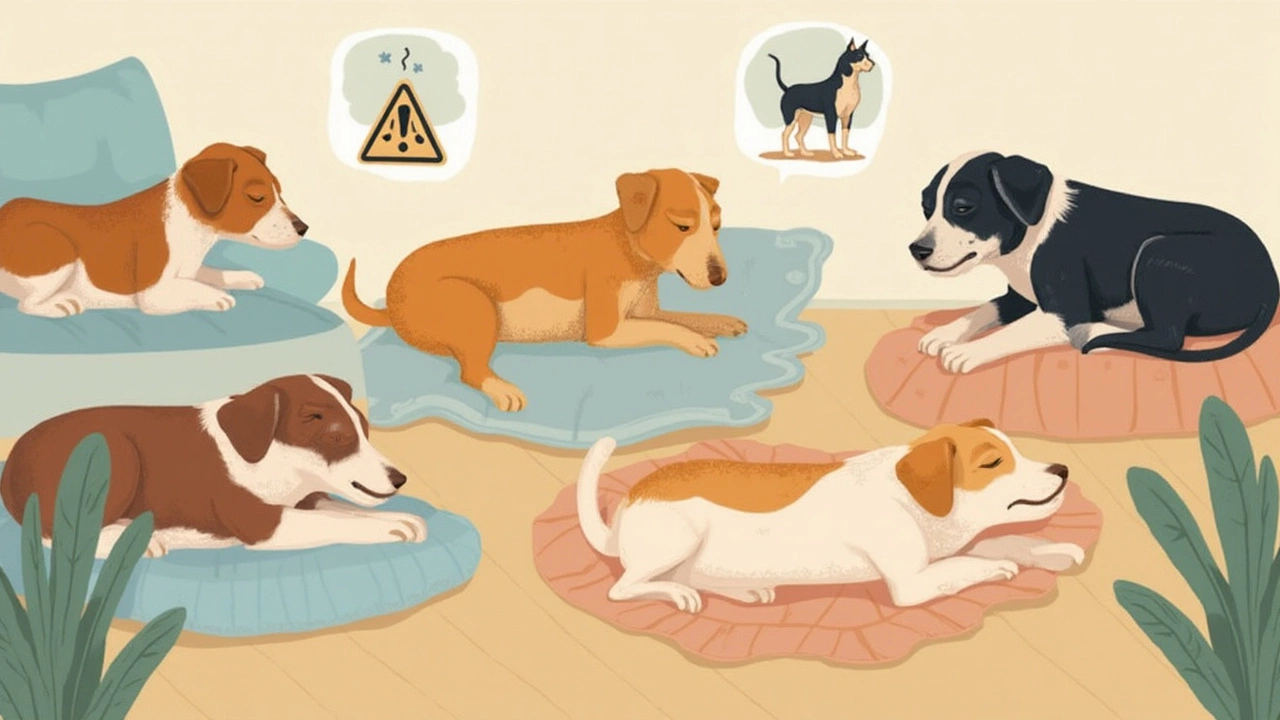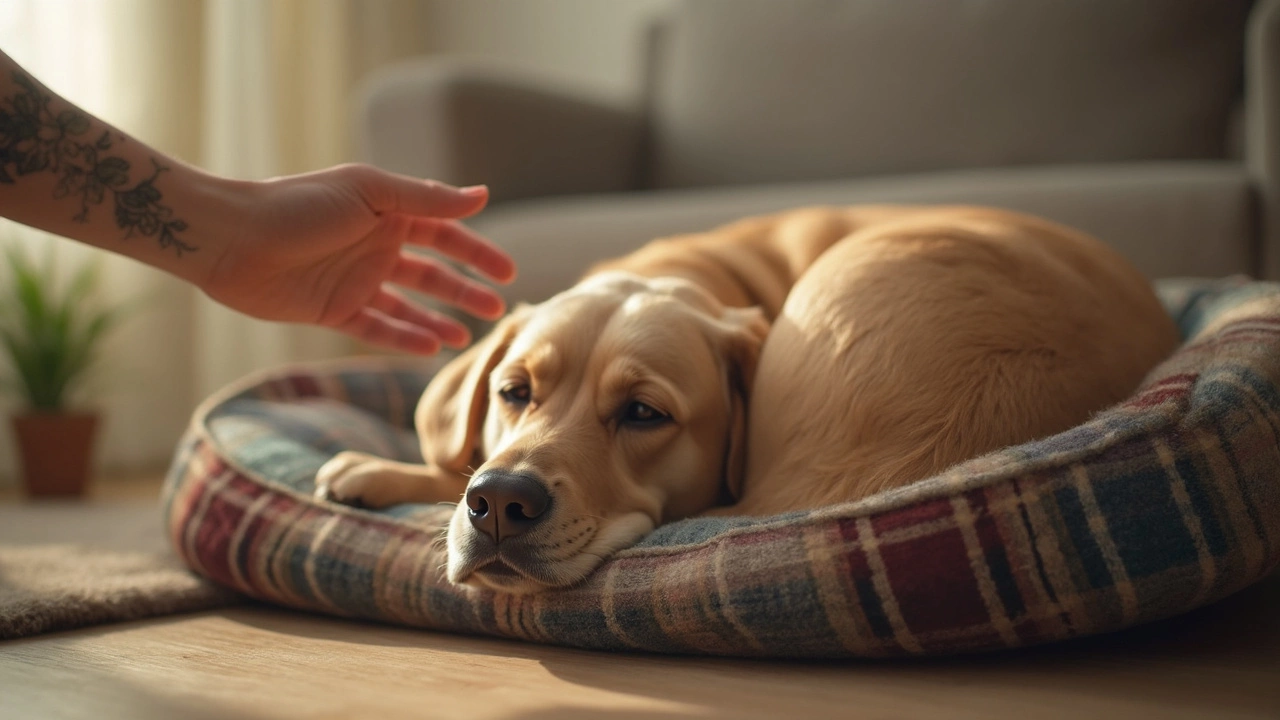Ever tried to sneak a gentle stroke on your dog as they twist and snore through dreamland? The urge is real—who can resist those twitching paws and soft, floppy ears? But, is your pet loving that surprise snuggle, or are you actually waking a sleeping giant (or at least a slightly cranky furball)? If you've caught yourself reaching out to stroke your pup while they sleep, you're not alone. Surprisingly, the answer isn’t universal. Just like people, every dog has its own comfort zone, especially when they’re off in dreamland. Some pups might melt right into your palm, but others could startle or snap if you interrupt their canine REM cycle. So, what’s really going on in your dog’s brain when you sneak in those midnight cuddles?
Understanding How Dogs Sleep and Why It Matters
Dogs don't just plop down and snooze like humans; their sleep is packed with phases, and understanding these stages helps make sense of their reactions. Adult dogs typically sleep around 12-14 hours a day, while puppies can clock in a whopping 18-20 hours. But, not all that sleep looks the same. Just like people, dogs go through both REM (Rapid Eye Movement) and non-REM phases. REM sleep, the phase with all the twitching, is when your pup is likely dreaming—maybe about chasing rabbits or guarding the couch from invisible burglars.
During REM, dogs are pretty vulnerable. Their brains are firing away, processing memories and feelings, just like ours. Waking or startling them during this stage can leave them confused or even defensive. If you’ve ever nudged your sleeping dog only to be met with sudden yelping, a jump, or a bit of a snarl, that’s likely because you caught them mid-dream. This phenomenon isn’t unique to dogs—humans can become disoriented when woken abruptly from a dream, too!
Non-REM sleep, on the other hand, is a bit lighter, often the stage where they can sense movement around them and may wake with a tail wag, ready for attention. Still, sleep is precious for your pup’s health, especially for growth, immune function, and mood regulation. If you find yourself constantly disturbing them, remember: chronic sleep disruption can leave dogs feeling stressed, cranky, and less playful.
Curious about how deeply dogs can sleep, or how their sleep cycles compare to ours? Check this out:
| Species | Average Sleep Per Day | % REM Sleep |
|---|---|---|
| Human | 7-8 hours | 20-25% |
| Adult Dog | 12-14 hours | 10-12% |
| Puppy | 18-20 hours | Approx. 20% |
| Cat | 12-16 hours | 16-25% |
Notice how adult dogs actually spend less time in REM sleep than humans, but their overall sleep is much longer and broken into multiple naps throughout the day.
Do Dogs Actually Enjoy Being Stroked in Their Sleep?
Here comes the million-dollar question: does your dog actually like being stroked while asleep? Well, it really depends on the dog and when you try. Some pups seem to love contact any time—you could argue that cuddling is their favorite sport. My own dog, Rex, will roll over if he senses even the faintest touch, paws in the air, tongue lolling out, begging for a belly rub. But my neighbor’s retriever? He growls if anyone so much as grazes his fur during nap time.
There’s science behind these preferences. Experts from the Sleep and Cognition Lab at the University of British Columbia found that sudden contact during deep sleep can be surprising—even for naturally mellow dogs. Large dogs and older dogs, in particular, tend to be more protective of their sleep. Puppies, used to being handled and extra snuggly, are sometimes more tolerant, but even they have limits.
There are a few signals that show if your dog likes those sleepytime strokes. Look for relaxed ears, a soft, wagging tail, or a gentle snuggle into your hand. On the flip side, some warning signs mean "back off":
- Sudden stiffening or jerking away;
- Growling or low rumbling;
- Lips curling, or a teeth-baring snarl;
- Heavy sighing, grumbling, or deep moans;
- Snapping, even if it’s not aimed at you.
If your dog shows any of these signals, it's best to avoid waking them for affection. The last thing you want is to break the trust you’ve worked so hard to build—or to land yourself on the business end of a startled yawn with teeth.
For dogs that love contact, touch releases oxytocin (the "love hormone"), which builds your bond and keeps them feeling happy and secure. But forcing contact, especially mid-snooze, can do the opposite. It's definitely not about you—some dogs just like their beauty rest, uninterrupted!

Reading Your Dog’s Body Language—When Is It Safe to Stroke?
So how can you tell if your pal wants you to stroke them during sleep? The answer lies in body language. Dogs are experts at telling us how they're feeling—if we know where to look. Pay attention to your dog’s position: a fully sprawled, belly-up pose or gentle, rhythmic breathing often signals safety and relaxation. If they’re curled into a tight ball, paws over their face, or tucked tail, they’re probably not open to touch.
Ever noticed why some breeds seem more tolerant than others? It’s partly down to their genetics and upbringing. For example, Labradors and Golden Retrievers—famously touch-happy—often enjoy closer contact than herding or guarding breeds like German Shepherds or Chihuahuas, who tend to be more sensitive and alert.
A study from Cambridge University in 2023 observed over 500 dogs and discovered that 64% of them preferred to be left alone while in deep sleep, regardless of age or breed. The same research highlighted that dogs who were regularly startled awake by touch showed more signs of stress during the day—chewing, pacing, or excessive barking.
But, if your dog is the exception, and seeks you out—even in sleep—embrace it! My cat Luna often triggers the dog’s sleep reflexes, and sometimes Rex just grunts, then scoots closer for comfort. Their bond is like a slow-motion pillow fight more than an actual nap, but you get the point: watch how your dog interacts with everyone in the home for extra clues.
Here are a few body language cues to look for before attempting a midnight snuggle:
- Soft, steady breathing;
- Relaxed muscles and a loose jaw;
- Gentle tail swishing or slow tail wagging (not stiff);
- No signs of tensing, growling, or snapping;
- If your dog "leans" into your hand after initial contact, it’s a good sign!
Best Practices for Petting Sleeping Dogs—And When to Keep Your Distance
So, should you pet your dog while they’re napping? If your answer after all this is, "Sometimes, but it depends," you’re right! Here’s the best way to approach it:
- Start slow. Gently call your dog’s name to see if they respond before touching. If you get a tail wag or lazy eye peek, you’re safe.
- Avoid petting near the face, legs, or tail while your dog is asleep. If you must touch, go for the shoulders or back—areas where they’re less sensitive to surprise.
- Never wake a dog abruptly, especially children. Even the sweetest dog can bite if startled awake.
- Reward your dog’s calm response with a soft voice and affection, but back off at signs of discomfort.
- Teach kids (and guests) the golden rule: "Let sleeping dogs lie." It’s not just an old saying—it’s solid, bite-proof advice.
- If your dog is elderly, arthritic, or recovering from an illness, extra caution helps. These dogs may need more sleep and can be easily startled or grumpy if disturbed.
- Try offering a soft blanket, bolster, or other comforting items in their bed to encourage self-soothing, so you don’t feel tempted to reach in uninvited.
At the end of the day, your dog’s happiness comes down to respecting their space. We humans crave connection, but for our furry friends, undisturbed sleep is pure gold. Dogs show trust by sleeping near or on us—interrupting it too often risks breaking their confidence and making them restless sleepers. Remember—the bond you share with your dog isn't built in the quiet moments alone, but in respecting their needs as much as your own. And if you’re itching for some puppy love, wait till they're awake and give them a treat, or grab a leash and go for an adventure. That wagging tail and slobbery kiss you'll get as a thank-you will remind you it was worth the wait.
Before you sneak in that next sleepy snuggle, remember: dogs might love affection just as much as you love giving it, but only when they’re ready. And trust me, nothing beats the feeling of a happy, rested pup trotting your way for some well-timed attention.
